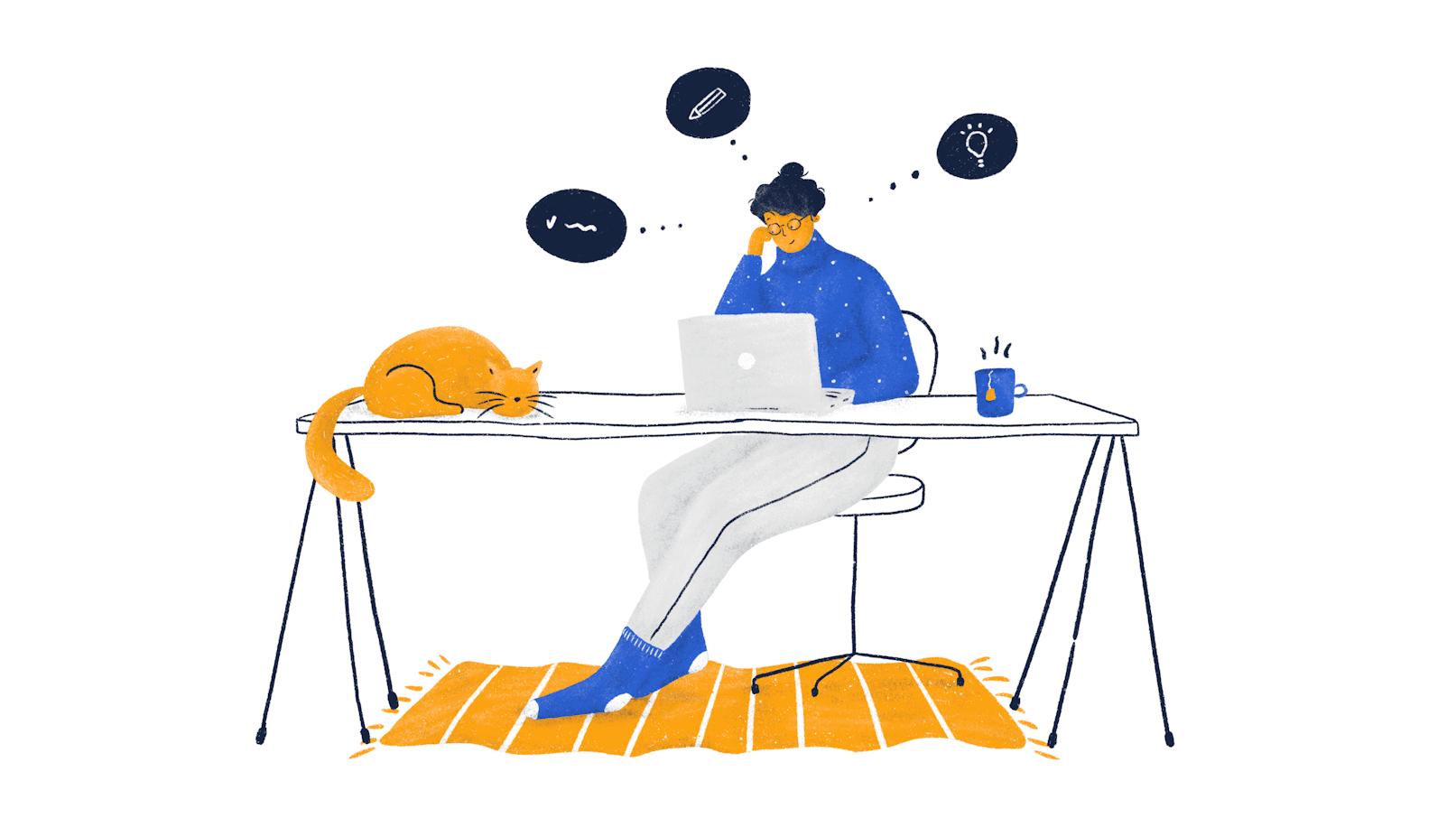Design briefs are a very, very overlooked piece of documentation. To many, it seems like a formality, but in reality, it is one of the simplest and most efficient ways to ensure that your expectations will match what you get at the end of a contract with a designer or an agency.
A well-put-together brief will end up being a critical reference point for your design project that will guide designers and, as a result, save you a boatload of time on impromptu Zoom calls and endless email threads.
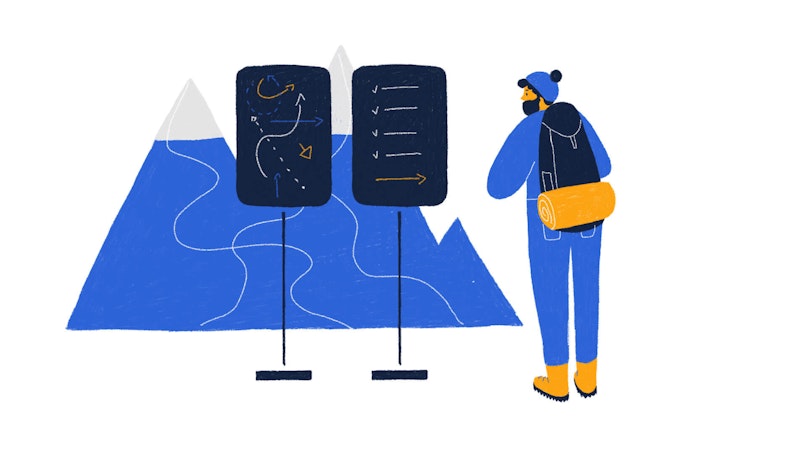
Looking for a world-class product design team?
Then look no further! We can get started on a new project in days.
Contact usIn this article, we’ll take a closer look at the components of a design brief, as well as provide you with a sample that you can use for guidance.
Let’s get into it.
What goes into a design brief
It’s critical to underline that none of the brief sections should be discounted and written off—they’re there for a good reason. As we mentioned above, the more time a business invests in this document, the more time it’ll save in the long run and the higher the chances of a successful outcome.
Company intro
Don’t be fooled by the apparent simplicity of this section. A designer can google a quick overview of your business—the problem is that it’s not what they’re really looking for.
Think about it this way, UX designers specialize in extracting valuable information from a wide array of sources like quantitative and qualitative user research, competitor research, business needs and positioning, and turning them into visual experiences. Whatever you include in your company intro will have a massive impact on how the project will be headed.
Definitely, briefs are supposed to be “brief,” but consider ditching the marketing-tailored company outline and reframing it in a way that designers will find useful—what the company does, who it serves, and what it aims to achieve. Less fluff, in this case, is always better.
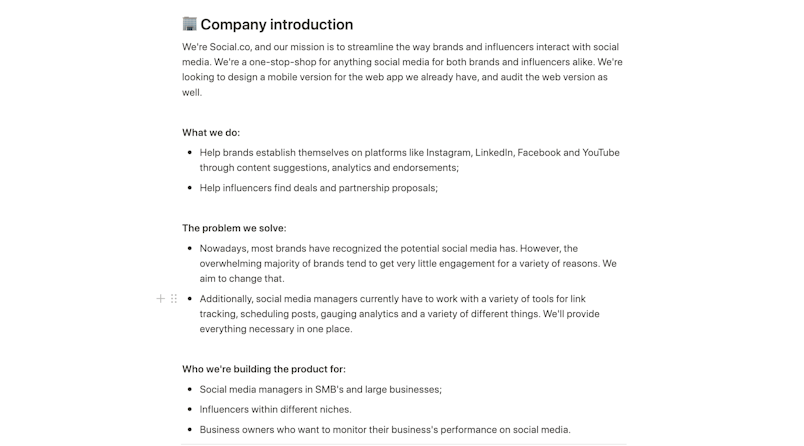
Here's an example of a company intro we have in our template.
Acceptance criteria & scope
This is the part where you’ll outline the specific deliverables you’re looking to get. Being clear about the acceptance criteria will also help align your expectations in regards to the format of the delivered work, its structure, and a host of other parameters. It’s worth taking the time to think this part through very carefully in order to avoid further conflicts and misunderstandings.
This part of the brief will also have a significant impact on the cost of the services you’ll be provided with. If you’re not entirely sure about the exact deliverables you’ll need, it’s always a good idea to talk to the design provider—they’ll definitely be able to help you navigate the peculiarities.
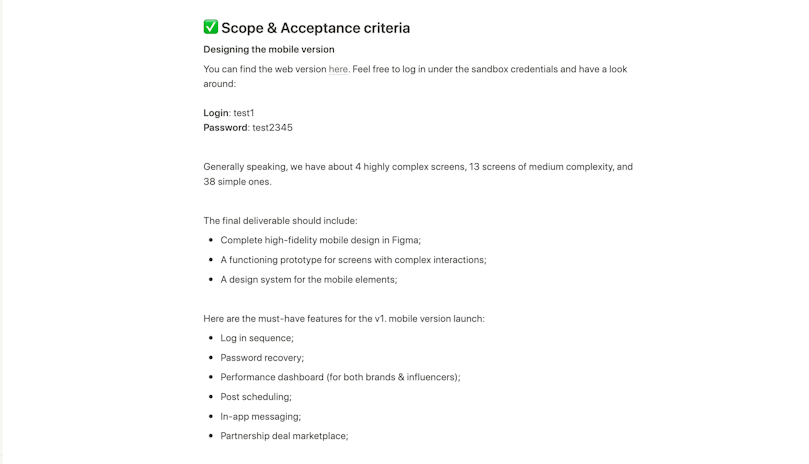
An example of scope & acceptance criteria in our template
Goals & objectives
There’s nothing random in design, or at least there shouldn’t be. As a business, it’s imperative for you to openly state what you’re looking to achieve via the design services that you’re acquiring.
Think of the issues that your company is trying to address and how design can help you do that. And it’s really important to be as straightforward as possible here—every single bit of critical information will nourish the design team's decision-making process.
Looking to 5x your sales? Mention it. Think your mobile site is clunky? Mention it. Want to give your brand a fresh new look? Mention it.

An example of goals in our template
Competitors
An overview of your competitors is very tightly connected to your goals as an organization. Are you trying to fit in or disrupt? What are the things that you do better? How do you express that in design?
This information is critical to the people providing you with design services since it will provide them with a variety of reference points that will help them better navigate the task.
Similarly, it provides them with an opportunity to analyze the design decisions of your competitors, as well as the stylistic conventions of the industry.
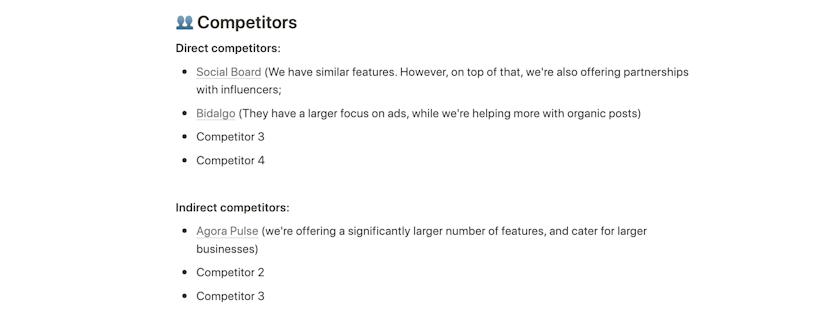
An example of listing competitors in our template
Target audience
Everyone deserves to have access to good design. However, there can’t be one single design solution for everyone. People are different—they have different needs, aspirations, and problems, which is why it’s critical to provide your design service provider with an in-depth understanding of the people you serve.
It’s always best to take the extra step and go beyond basic demographic information and actually have a fully-fleshed customer persona. There’s a bunch of extremely relevant information you can include in this section, even things like the types of stores they go to, their favorite books, their outlook on life, etc.
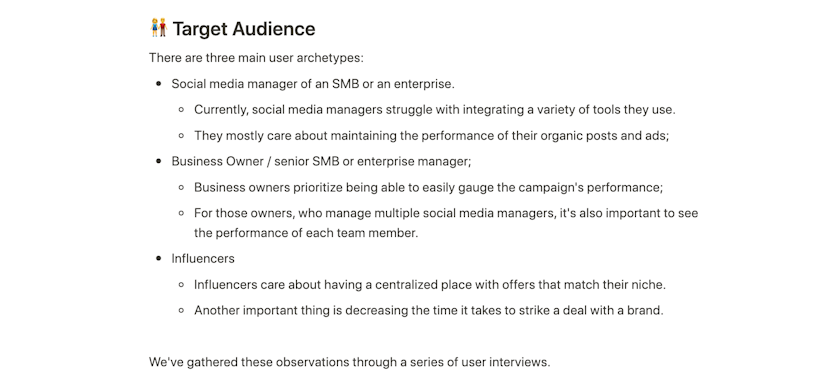
Timeline & budget
Having a shared understanding of the timeline and the budget will help keep both parties on track—and it’s important to mention that both these things have to be addressed early on in your communication. Design projects can last many months, and confining a service provider to a tight schedule will more often than not end up harming the end product.
Budget is also something that needs to be discussed transparently. There’s a fair bit of time invested in communication until you end up sending a brief. Finding out at the last minute that the agency will actually want five times the amount you expected to pay is an avoidable situation—and transparency is key to doing so.
Consider adding a contingency cushion for some of the problems that may arise during the process. If these funds aren’t used within the project delivery date—they can be subtracted from the total sum.

An example of timeline and budget in our template
What’s been done so far
Unless you’re starting from scratch, you likely have a lot of the assets done already. It’s always a great idea to share deliverables like style guides, your design system, previous designs, wireframes, mood boards, as well as share your thoughts on them.

Example of this sesction in our template
Design brief example
To help you consolidate the things we've gone over, we prepared an example that you can find here. It features a design brief from a fictional app that's looking for design help. Feel free to use and copy if you need 😄
Understanding the design brief
Now that you have seen a great example of a design brief, you might want to create one. Let's dive deeper into the crucial details and how to navigate challenges when they arise.
Looking to learn more about effective design briefs? Read on!
Defining the purpose of a design brief
A design brief is like a roadmap for your design project. It’s that important document that lays out the plan and keeps everyone on the same page. Think of it as the starting point for a successful design journey.
What’s the point of a design brief? It’s all about clarity and direction. A well-crafted brief is a clear communication tool between you and your design team. It spells out your goals, expectations, and the problem you want to solve. This shared understanding is the solid foundation you need for a successful project.
Why a design brief is vital for the design process
A design brief isn’t just a document; it’s a living, breathing part of your project. It guides designers, keeps everyone focused, and helps prevent scope creep. Similar to how a compass points people in the right direction. A reliable design brief saves time, money, and headaches.

Image by Freepik
Key stakeholders involved in the design brief
Everyone who has a stake in the project should have a say in the design brief. This includes:
Client: The individual or organization initiating the project.
Design team: The designers responsible for creating the product or service.
Project manager: The individual overseeing the project timeline and resources.
Target audience: The end-users of the product or service.
Subject matter experts: Individuals with specialized knowledge relevant to the project.
By involving everyone from the start, you ensure they are all on the same page and that the final product meets their needs.

Image by Freepik
Writing effective design briefs
A well-written design brief is clear, concise, and informative. It should be easy to understand for both the client and the design team. Let's dive into some tips for creating an effective design brief.
Tips for clear and concise communication
Here are tested and trusted tips that will come in handy when writing a design brief:
Use plain language and avoid jargon.
Be specific about your goals and expectations.
Break down complex information into smaller, digestible chunks.
Using visuals to enhance understanding
Sometimes, a picture is worth a thousand words. Incorporate visuals like mood boards, sketches, or wireframes to complement your written content. Visuals help to clarify your vision and inspire the design team.
Collaboration and feedback
A design brief is a living document. Encourage feedback and input from all stakeholders. Be open to suggestions and modifications. Collaboration ensures that everyone is aligned with the project goals.
Review and approval process
Outline the review and approval process upfront. Specify who will be involved in the review, how feedback will be provided, and the timeline for revisions. This helps to streamline the project and avoid delays.
How to overcome common design brief challenges
Creating a perfect design brief is challenging. Even the best-laid plans can encounter obstacles. Let's explore some common challenges and how to overcome them.
Addressing ambiguities and inconsistencies
A poorly defined design brief can lead to misunderstandings and delays. To avoid this, be as specific as possible when outlining your project goals and requirements. Use clear and concise language to minimize ambiguity. Finally, review the brief carefully with stakeholders to identify and resolve inconsistencies before moving forward.
Managing expectations and scope creep
It's really essential to set realistic expectations from the outset. Clearly define the project scope and avoid adding new requirements after the brief is finalized. If changes are necessary, communicate them clearly and assess their impact on the project timeline and budget.
Building effective relationships with designers
A strong relationship with your design team is crucial for a successful project. Open communication, trust, and mutual respect are essential. Provide clear and constructive feedback, and be open to their suggestions and expertise. In a collaborative environment, it's much easier to overcome challenges and achieve exceptional results.
Conclusion
By investing time in creating a clear and comprehensive document, you set the stage for effective collaboration and exceptional outcomes. With the guidelines we've outlined in this article, you can create design briefs that inspire and inform your design team.
Remember, a great design brief is a living document. It's essential to enable open communication and be willing to adapt the brief as the project evolves. By embracing these principles, you'll be well-equipped to create design projects that exceed expectations.
For further insights and inspiration, explore additional resources on design methodologies and an efficient UX design process.
FAQs
What should I include in a design brief?
A design brief should outline your project goals, target audience, desired outcomes, and any existing assets. Include details about the project scope, timeline, budget, and preferred design style. Clear communication is key, so use simple language and avoid jargon.
How long should a design brief be?
There's no strict word count, but a design brief should be concise and informative— 1 or 2 pages. Aim for a balance of detail and brevity. Focus on providing essential information without overwhelming the design team.
Who should be involved in creating a design brief?
Involve key stakeholders, including the client, project manager, designers, and potentially subject matter experts. Their input ensures the brief aligns with project goals and reflects the target audience's needs effectively.

